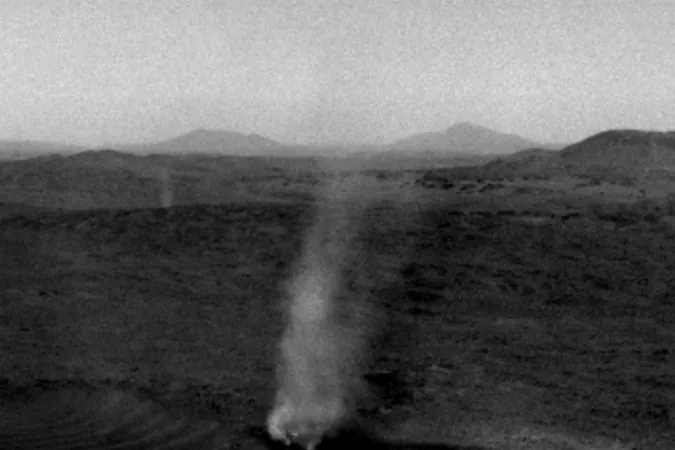
NASA's Mars Rover Captures Spectacular Showdown of Dust Devils!
2025-04-03
Author: Wei
NASA's Spectacular Discovery on Mars
Mars has proven to be a dramatic stage for nature’s ferocious phenomena, and recently, NASA's Perseverance rover witnessed an astonishing spectacle. In an extraordinary scene on the Red Planet, a giant dust devil mercilessly devoured its smaller counterpart, morphing into a formidable swirling column of air and dust.
Perseverance's Imaging Mission
The six-wheeled Perseverance rover was engaged in an imaging experiment aimed at unraveling the mysteries of the Martian atmosphere when it caught these dust devils in action. Using its advanced navigation camera, the rover snapped fascinating images of multiple dust devils performing their chaotic dance on the western rim of Jezero Crater, specifically in a region intriguingly named Witch Hazel Hill.
A Captivating Display
The captivating footage was transformed into a short video, prominently featuring the larger dust devil, which measured an impressive 210 feet (65 meters) across, alongside a smaller twister, about 16 feet (5 meters) wide, trailing closely behind. In the background, two more dust devils were seen swirling, adding to the dramatic display.
A Twist of Fate
In a twist of fate, the smaller dust devil unfortunately marched straight into the embrace of the larger one. Mark Lemmon, a scientist working with the Perseverance team at the Space Science Institute in Boulder, Colorado, shed light on this phenomenon: “Convective vortices—aka dust devils—can be rather fiendish. These mini-twisters wander the Martian surface, gathering dust along the way and obscuring visibility in their vicinity. When two dust devils cross paths, they either neutralize each other or merge, leading to one overpowering the other.”
A Historical Perspective
Dust devils are not a new discovery; they were first observed by NASA’s Viking mission in the 1970s from orbit. Several decades later, during the Pathfinder mission, the first image of a dust devil from the Martian surface was taken as one roared past the lander. Since then, NASA’s roaming Martian rovers have continued to capture a plethora of dust devil performances.
The Martian Environment
Unlike Earth, where tornadoes reign due to a stable atmospheric structure, Mars' thin atmosphere only supports dust devils. As surface air heats up and meets cooler, denser air, it begins to swirl, creating these rotating columns. As this process continues, the dust devil gains speed and collects dust, leading to the spectacular whirlwinds we see.
The Fleeting Nature of Dust Devils
For those who feel sympathy for the smaller dust devil in this cinematic showdown, it might provide a bit of comfort to know that the larger dust devil likely faced a similar fate shortly afterward. “Dust devils on Mars only last about 10 minutes,” Lemmon noted, highlighting the fleeting nature of these awe-inspiring spirals.
Conclusion
So, as we gaze at these breathtaking Martian phenomena, we are reminded of the ferocity and beauty of nature, even millions of miles away on a distant planet!

 Brasil (PT)
Brasil (PT)
 Canada (EN)
Canada (EN)
 Chile (ES)
Chile (ES)
 Česko (CS)
Česko (CS)
 대한민국 (KO)
대한민국 (KO)
 España (ES)
España (ES)
 France (FR)
France (FR)
 Hong Kong (EN)
Hong Kong (EN)
 Italia (IT)
Italia (IT)
 日本 (JA)
日本 (JA)
 Magyarország (HU)
Magyarország (HU)
 Norge (NO)
Norge (NO)
 Polska (PL)
Polska (PL)
 Schweiz (DE)
Schweiz (DE)
 Singapore (EN)
Singapore (EN)
 Sverige (SV)
Sverige (SV)
 Suomi (FI)
Suomi (FI)
 Türkiye (TR)
Türkiye (TR)
 الإمارات العربية المتحدة (AR)
الإمارات العربية المتحدة (AR)